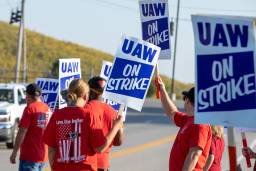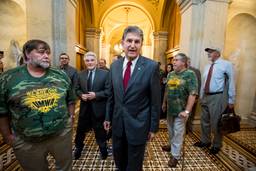On Wednesday, the AFL-CIO’s affiliated group, Working America, announced its goal of mobilizing the jobless over the issues of jobs and trade. This comes at a time when there are concerns among some Democratic operatives and progressives over a supposed “enthusiasm gap.” The flap over Robert Gibbs’ dissing of the “professional left” only exacerbated those concerns. As strategist Mike Lux points out, “The White House right now has very little in the way of strategy for reaching out to the progressive community.”
Yet there are few voters as motivated to support jobs creation measures and, in theory, a Democratic victory in November as the unemployed – if the Democratic strategy of scaring voters over a potential return by the GOP to Congressional power takes hold.
As AFL-CIO spokesman Eddie Vale told CQ: “Obviously a lot of people are talking about enthusiasm and turnout. A lot of these people could be discouraged from voting this year because of the economy or their own personal employment situation. “Our message is, ‘If you are concerned about jobs, it is more important than ever that you vote in this election.’”
Working America, with its three million members who aren’t yet union members, outlined its plans in a press release:
Working America is mobilizing unemployed voters through a combination of face-to-face and mail campaigns. In addition to talking to everyday voters on the streets, field organizers in 12 cities are talking to unemployed workers at unemployment offices and job training facilities. Workers at these facilities will have the chance to fill out “Help Wanted” petitions to send to Congress asking them what they’ve done to create jobs and help unemployed workers. Working America organizers are also reaching out to members by mail and phone to pledge to vote in the November elections.
“Millions of people are unemployed and underemployed, and millions more are worried about the future. Twenty-five percent of Working America members who are working are afraid they will lose their jobs,” said Karen Nussbaum, director of Working America. “Yet some politicians are willing to play politics with the survival of unemployed workers and their families. We’ll make sure that unemployed workers get out and vote, and that they know the records of the candidates on issues like extending unemployment insurance, investing in jobs and preventing outsourcing.”
It’s not clear, though, how a high a priority the AFL-CIO will place in its messaging on seeking new legislative authority to extend aid to the “99ers” whose benefits have expired, although the labor union has drawn a sharp contrast between Democrats and the resistance by the GOP to extending unemployment insurance to those already entitled to receive it.
But what is clear is that they’re determined to overcome any lingering frustration and reluctance by progressive Democrats to turn out in what AFL-CIO President Richard Trumka has called “the most crucial election in 75 years.”
At an AFL-CIO Battleground States Conference in early August and other meetings, labor leaders highlighted the themes and financial commitment unions will use to motivate voters. As recapped by Daily Kos:
Richard Trumka, head of the AFL-CIO, gave a fiery speech yesterday, calling on union members to get out the vote for Democrats:
“They just want you to sit this election out. They figure that if they can mobilize the rightwing radicals, the corporate conservatives, the Tea Party fanatics and the talk show fans, and if they can anesthetize the rest of us, then they can win this election in a walk,” Trumka said. “It’s up to us to mobilize the working Americans who have the most to lose from going backwards and the most to gain from moving forwards…”
The AFL-CIO spent over $53 million in 2008 on candidates and plan to spend more in 2010 to keep Democratic majorities:
“After the speech, AFL-CIO’s deputy political director Michael Podhorzer told reporters that it’s not a time to push an agenda but to rally the base. ‘We’re looking forward to a really big fight,’ Podhorzer said.”
Yet news organizations across the political spectrum – from the Huffington Post to the center-right Economist – are also highlighting discouraging polling figures that underscore how much of a challenge generating turnout could turn out to be in November.
The primary turnout results in Colorado, for instance, offered mixed results for Democratic hopes in November. As Huffington Post’s Sam Stein reported:
For all the chatter about the White House’s ability to get out the vote in Colorado’s Tuesday night primary, the election produced one statistic that could leave Democrats unsettled.The losing candidate in the Republican race, former Lt. Gov Jane Norton, actually earned more votes (197,143) than the winning candidate in the Democratic primary, Sen. Michael Bennet (183,521).
A voting breakdown like that is troubling enough for the party. That it occurred in Colorado – a state targeted by the Obama presidential campaign and turned into a potential Democratic stronghold in 2008 – makes it slightly more frightening.
Yet Stein also noted Democratic officials’ reading of the tea-leaves that gives room for optimism:
Eric Schultz, a spokesman for the Democratic Senatorial Campaign Committee, noted: “nearly three times as many people voted in the 2010 Democratic primary election in Colorado as participated in the 2008 Democratic presidential caucus in Colorado.” The Secretary of State’s office, meanwhile, reported that more than 35 percent of all Democratic votes on Tuesday evening were cast by voters who had no previous primary election vote history.“That means our team knows how to motivate unlikely voters (like the Obama surge voters) come the fall,” argued Schultz.
Whether that motivation extends to – or, more importantly, accelerates in – the general election is the essential question on the party’s mind. Operatives are increasingly convinced that electoral enthusiasm will play a determining role in 2010, which is why grumblings were audible on Capitol Hill after White House spokesman Robert Gibbs mocked liberal constituencies for their unreasonable demands.
On the other hand, the respected but right-leaning Economist found little to comfort Democrats in new polling, making the drive to mobilize the jobless even more important:
The present gap is really more of a chasm. Gallup, a pollster, reckons that a mere 28% of Democrats are “very enthusiastic” about voting, compared to 44% of Republicans. By the same token the Pew Research Centre found in June that only 37% of liberal Democrats were “more enthusiastic than usual” about going to the polls, compared with 59% of conservative Republicans…”You can’t deny the level of disappointment,” says Raul Grijalva, a Democratic representative from Arizona and head of the Congressional Progressive Caucus…The disillusionment of the Democrats’ base matters, says Charlie Cook, an electoral analyst, because mid-term elections have much lower turnouts than elections in presidential years, so the party faithful account for a higher proportion of votes. Parties with unhappy supporters, naturally, tend to do poorly in elections, says Jeff Jones of Gallup..
Progressive activists gamely insist that they can yet recapture some of the popular fervour that carried them to thumping victories in 2006 and 2008. If only a fraction of the almost 15 million first-time voters of 2008 (the vast majority of them Democrats) can be persuaded to turn out again, party organisers say, it could tip lots of races in their favour…
Groups that work with young people and minorities, who tend to favour the Democrats, promise big outreach programmes…But Mr Cook dismisses all this as wishful thinking. The elections in 2008 were unique in recent history for the number of young who voted; he cannot see that happening again. The enthusiasm gap has persisted for several months now, and is unlikely to close in the three that remain before election day, according to Mr Jones.
Yet if the groups – from labor to youth to minorities – that powered Obama to victory do turn out in sufficient numbers, the blood-letting that some Democrats fear can be reversed. The importance of these voters to Obama’s victory – and a Democratic win this November – was underscored in an important briefing paper by Project Vote’s Lorraine Minnite, a leading scholar on voting trends, “What Happened to Hope and Change?”
Minnite notes, “The 2008 electorate saw a significant – and perhaps decisive – shift among key demographic groups. Young people and minorities – and particularly young Americans of color – voted at record rates in 2008. Two million more African-Americans, and 2.3 million more voters under the age of 30, voted in 2008 and 2004.” In fact, the largest surge in participation came from the very lowest income bracket – households making less than $15,000 a year, voting at a rate nearly double that of 2004.
If the unemployed are similarly motivated in November, the economic crisis they’re facing and continuing high unemployment could make a positive difference in Democratic outcomes – but only if the Democrats can convince those and other voters they’d be far worse off if the Republicans return to power.






